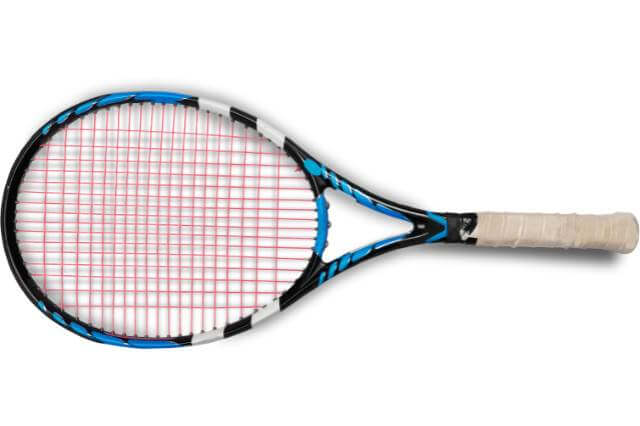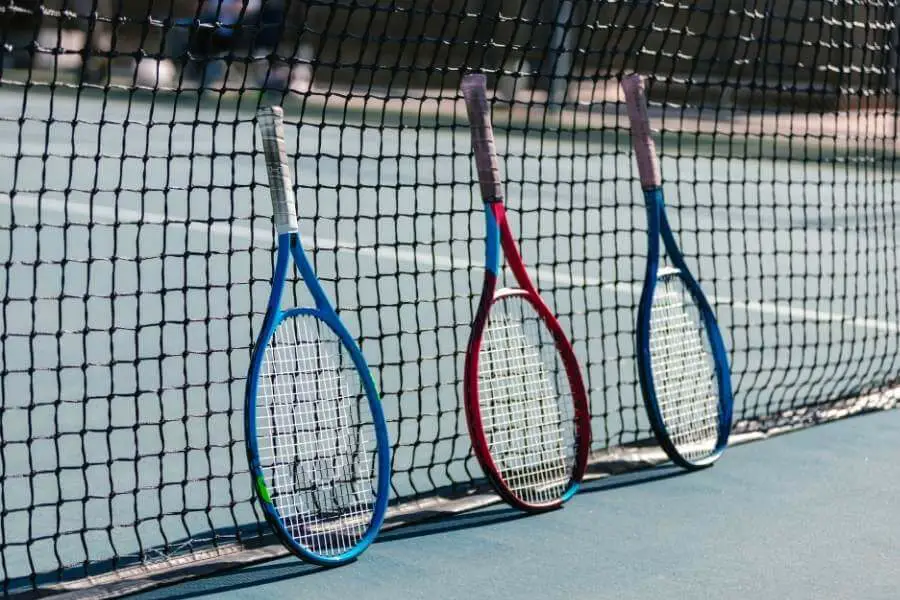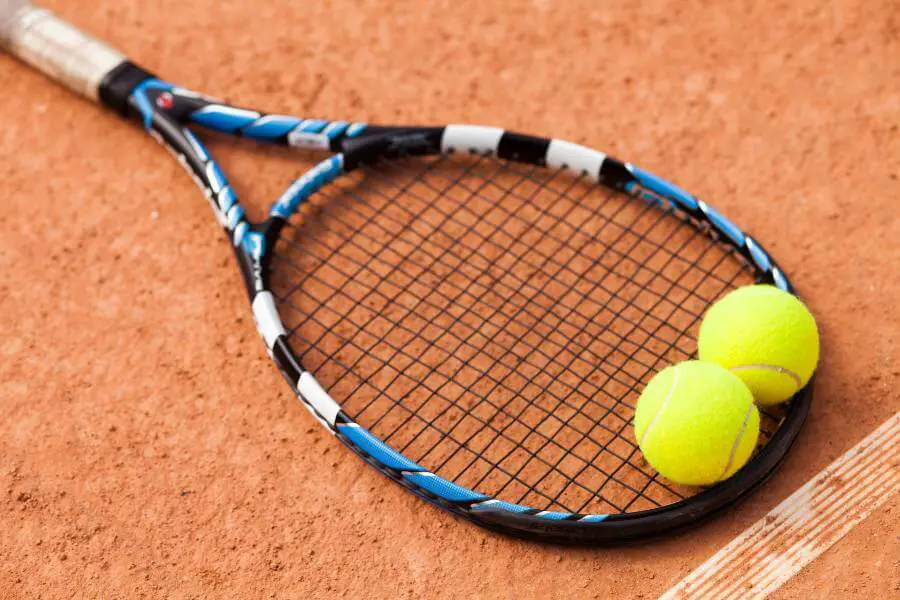You must pick the proper racket before you step onto a tennis court.
It’s crucial to understand each of the many components of the tennis racket and how they all function together to produce the ideal weapon for your forehands, backhands, serves, and volleys, even if the tennis racket you use relies on characteristics like size, strength, and talent.
Additionally, a professional tennis instructor will use terminology like these when instructing you.
In order to focus on your game and practice rather than struggling with terminology, it is crucial to have a better grasp of the components of a tennis racquet.
Table of Contents
What Are the Parts of a Tennis Racket Called?
Let’s dissect a tennis racquet into its component parts and provide a quick description of each one.

Butt
The plastic cover at the end of a racquet handle is known as the butt cap, but the term “butt” is more commonly used to describe the bottom of the handle.
Butt Cap
The butt cap, a piece of plastic that enlarges or flares out the bottom of a racquet’s handle to assist the racquet stay in a player’s hand, is referred to in this context.
Some butt caps have detachable trap doors that, when removed, may be a convenient place to add material to alter the weight of a racquet.
The size of the racquet’s handle and the logo of the maker are frequently printed.
Grip
The grip of a tennis racquet is the handle’s outer covering.
It offers a cushioned surface to shield the player’s hand from the handle’s rough surface and offers traction to guarantee a strong hold and prevent the racquet from slipping.
If more traction and perspiration absorption are required, you may change the basic grip with a different one or wrap an overgrip around it.
Grip Tape
You’ll discover grip tape near the top of the racquet’s handle, which fastens the grip to the racquet and keeps it from unraveling.
Handle
The full length of the region where a player inserts their hands to grasp the racquet is referred to as the handle.
To enhance the overall size of the tennis racquet and provide players with greater leverage and power, extended-length racquets often include longer handles.
A tennis racquet’s handle circumference or outside edge length can be anything from 4 and 4 5/8 inches.
To guarantee comfort and reduce the risk of harm from a handle that is either too tiny or too large, it is crucial to choose the proper size.
Collar
Some rackets have a rubber collar that goes over the grip tape for further security; this collar can also fasten an overgrip in place of traditional grip tape.
Handle Bevels
The eight sides or bevels on a racquet’s handle assist keep the racquet from twisting or spinning in a player’s palm.
They are also helpful for teaching beginners how to grasp a tennis racquet.
Throat
The throat is a triangular region directly above the shaft. It has two options: open and closed.
Today’s racquets are often only available in the open-throat type. We’ve also seen racquets in the past with closed throats.
The racquet is simple to swing because of the wide neck, which lets air move through.
It prevents too much air from allowing the racket to drag when swinging.
Additionally, the elasticity of the racquet is also determined by this region.
Shaft
The shaft is the area that is between the head and the handle. It joins the head to the handle.
It has a connection to the throat as well. You can either open or close your throat.
Head
It is the racket’s oval frame. Better performance is indicated by a larger head or tennis frame.
The huge frame rackets, however, are difficult to manage.
A tiny tennis frame, on the other hand, results in less power and simpler control.
Generally speaking, a head’s power increases with its size. More control equates to a smaller head.
Therefore, choosing the racket that best suits you is now quite simple.
The racket’s head is the major component that contributes most to power and plays a significant influence on performance.
In general, racquet heads range in size from 90 to 110 square inches, however, there are those with significantly larger heads.
Greater sweetspot and error tolerance are associated with larger heads.
Beam
The side of a tennis racquet is referred to as the beam, and depending on the model, this side may be thicker or thinner.
A racquet’s beam, which is sometimes disregarded but may have a big impact on how well it performs overall,
Wider beams are typically seen in power racquets, which improve stiffness while enabling the strings to move more freely and produce greater power.
Control racquets, on the other hand, often contain smaller beams, allowing for a more flexible frame while restricting string movement, adding to the control.
Placing several racquets side by side on a table or the floor makes it simple to compare the beams, which is something to keep in mind when buying a new racquet.
Rim
It is the racket head’s outside corner. The racket strings are fixed in this section. The key element that makes up the racket’s head is its rim.
It is manufactured particularly robustly to improve the performance of the racket. The measurements of the racket’s rim are known.
Grommet Strips
The racquet head is surrounded by plastic grommet strips.
To shield the strings from the protruding edges of the drilled holes that allow the strings to pass through, they are inserted through the side of the frame.
Grommets
At the end of the strings, close to the frame, are the grommets, which are little bits of plastic.
These are useful in preventing the strings from freely moving and being stroked by the racket frame.
If the strings can move freely, the racket has more power to provide.
Make sure the grommets are broader the next time you are seeking to get a power racquet.
Higher grommets, on the other hand, prevent the strings from moving freely. Therefore, it provides additional control.
Dampeners
Dampeners are the tiny components of a tennis racket that are placed on the string face immediately outside of the crossed strings.
They are constructed of rubber, and their sole purpose is to change the sound of the racket following the impact of a stroke.
Dampeners can be removed and are optional.
Bumper Guard
A bumper guard is located at the top of a racquet’s head to assist shield the strings and this region from the court when it occasionally scrapes against it.
Despite being made of sturdy plastic, bumper guards must be replaced in order to safeguard and extend your racquet.
The frame can become exposed if it isn’t changed, which might cause a fracture or early breaking.
Strings
Tennis strings offer a flat, trampoline-like striking surface by being a thin piece of material inserted across the racquet head.
The type of string you choose can have a significant influence on the overall performance of your racquet.
Tennis string is available in a number of gauges, or thicknesses, and materials.
A racquet’s power, control, spin, and longevity can all be affected by the tension at which you string it.
Main Strings
The mains are the vertical strings that run within a tennis racquet’s head.
Cross Strings
The crosses are the horizontally oriented strings.
Face
Tennis strings are strung together to create the face of a tennis racquet.

FAQs
What Are the Three Primary Components of a Tennis Racket?
The head, shaft, and handle are the three primary components of a tennis racket.
Between these main components are all additional components.
What Function Does the Dampener Serve in a Tennis Racket?
A little rubberized cushion known as a dampener can be fastened to the handle’s bottom.
It is often utilized to lessen the unwelcome vibrations that the frame produces in order to prevent potential arm and wrist injuries.
What Material Do Tennis Rackets Contain?
Tennis rackets are constructed from a mix of steel, graphite, aluminum in a number of alloys, and kevlar.
Graphite, however, is the primary material.
Final Thoughts
You just discovered every component of a tennis racket. I am aware that a lot of information may initially seem daunting, so don’t worry.
You may just come back here whenever you forget something to jog your memory until you can identify the components of the tennis racket with ease.
I am aware that learning may be challenging and unpleasant at times.
This essay seeks to impart fundamental knowledge because doing so will make a beginning more perceptive.
Having a greater grasp of the components of your tennis racket will boost your on-court confidence and, over time, assist you in beginning to master the sport.
Further Reading:

